Google Nexus 4 and Nexus 10 Performance Preview
by Anand Lal Shimpi & Brian Klug on November 2, 2012 11:00 AM ESTGPU Performance
This section is particularly exciting because it's our first look at ARM's new Mali-T604 GPU in our standard mobile 3D performance suite. We've already seen the Nexus 4's Adreno 320 in action, but the Nexus 10's behavior here should be interesting to see.
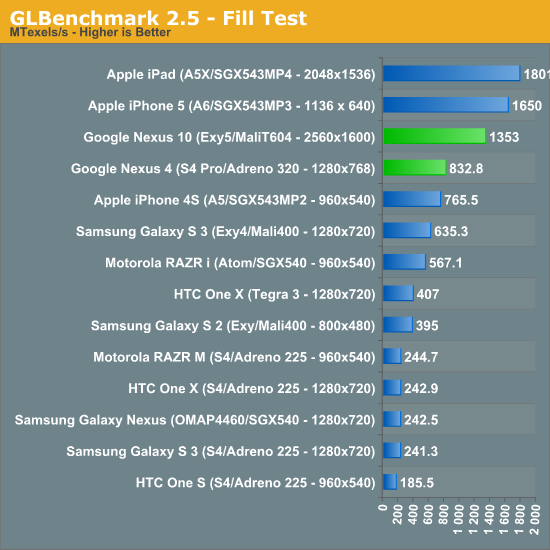
As far as raw fillrates are concerned, both Nexus devices do quite well here at their native resolutions. The iPad and iPhone 5 are both quicker, but we're still good gains over the previous generation of hardware - particularly for the Mali-T604. Compared to the Mali-400MP4 in the Galaxy S 3, we're seeing more than 2x the performance out of ARM's latest GPU.
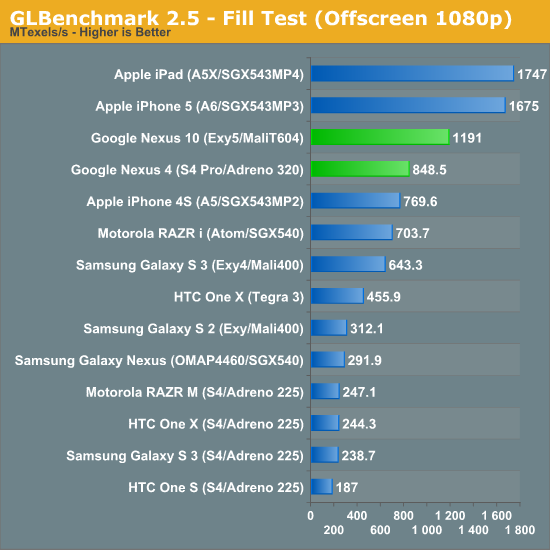
At normalized resolutions the standings don't really change.
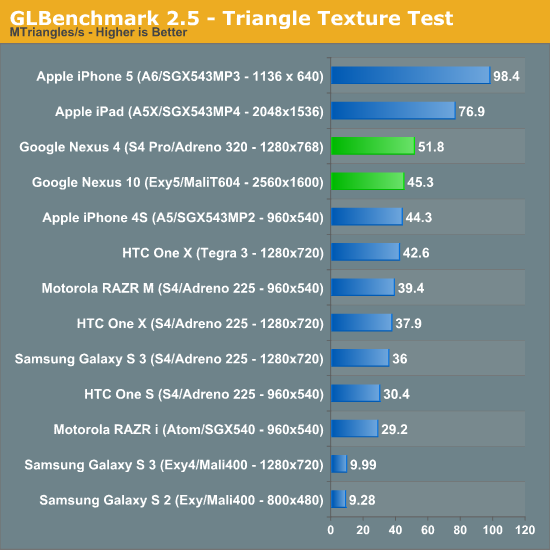
The T604 is ARM's first unified shader architecture, which gives it far more balanced pixel/vertex shader performance. The result is a more than 4x increase in triangle throughput compared to the Mali 400MP4. It's not enough to give the Nexus 10 the edge over the latest Apple devices, but it's a huge improvement over where ARM was in the previous generation. The Adreno 320 continues to be quite strong here as well.
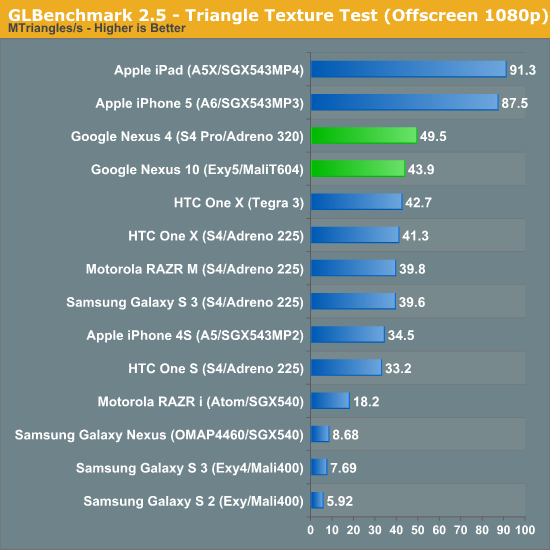
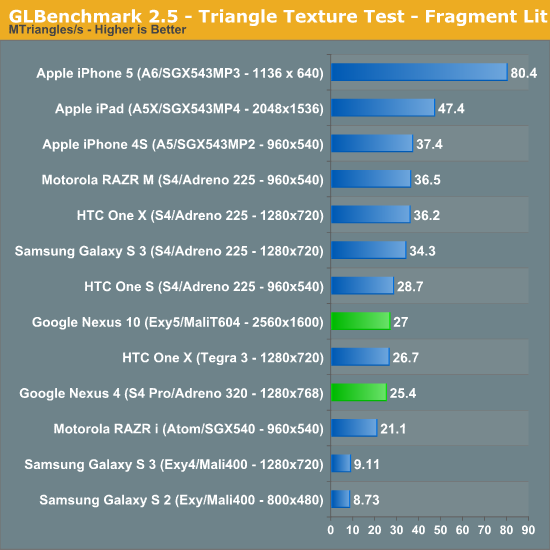
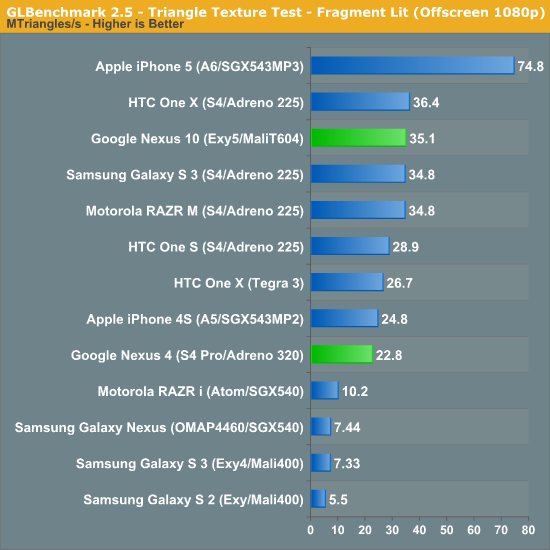
Once again we're seeing huge gains for the Mali-T604 compared to the Mali-400MP4. The Adreno 320 in the Nexus 4 actually performs worse than the Adreno 225 in older devices, possibly due to thermal throttling we saw on the Nexus 4 sample during periods of heavy load.
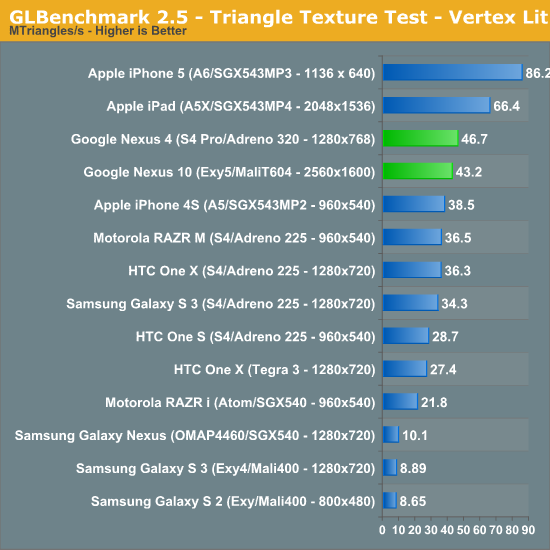
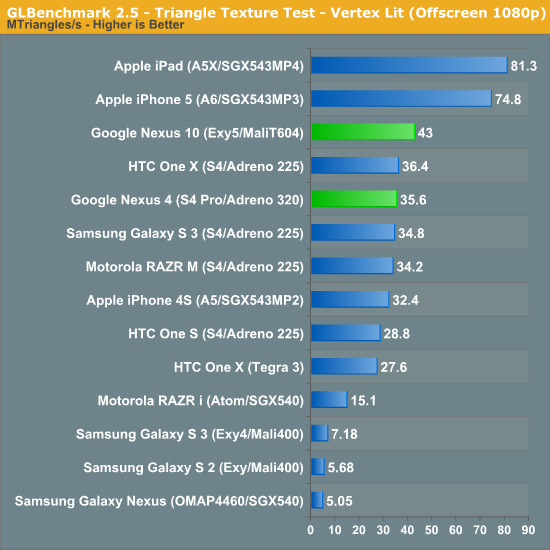
ARM shows the biggest gains here once again thanks to its move to a unified shader architecture. The Adreno 320 does ok here but it's really no better than the 225, I suspect there is some thermal throttling happening on the device.
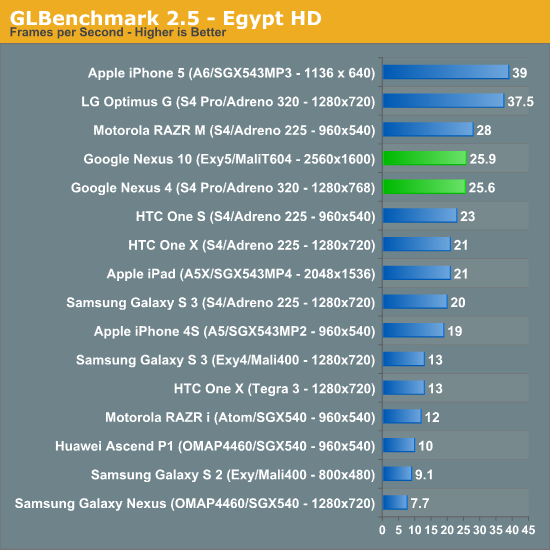
At native resolutions, the Nexus 10 and NExus 4 are both capable of putting out decent frame rates in Egypt HD. What this data tells us is they'll likely be able to run current and even some future titles, at native res, at 30 fps without much of an issue.
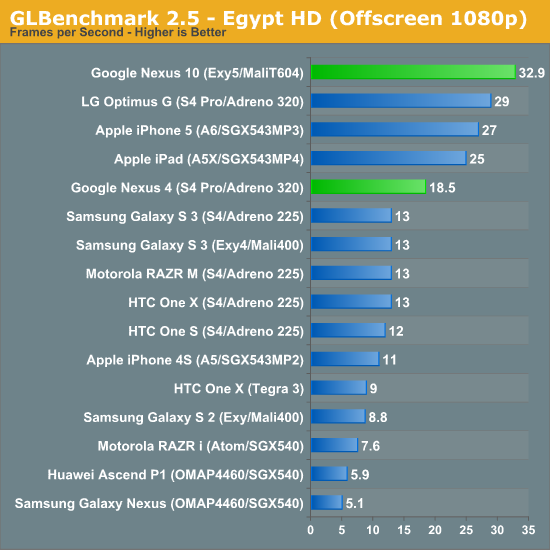
Normalize resolution and the Mali-T604 actually does very well here, setting a new performance record. Despite being based on the same hardware, the Optimus G is able to post a much higher score here than the Nexus 4. The explanation is simple: the Optimus G can't complete a single, continuous run of GLBenchmark 2.5 - the app will run out of texture memory and crash if you try to run through the entire suite in a single setting. The outcome is that the Optimus G avoids some otherwise nasty throttling. The Nexus 4 on the other hand manages to complete everything, but likely quickly throttles its clocks down due to thermal constraints. The Nexus 4 was really hot by the end of our GLBenchmark run, which does point to some thermal throttling going on here. I do wonder if the Snapdragon S4 Pro is a bit too much for a smartphone, and is better suited for a tablet at 28nm.
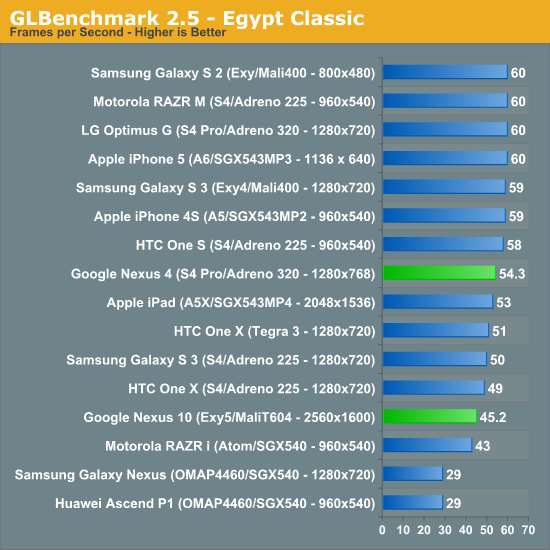
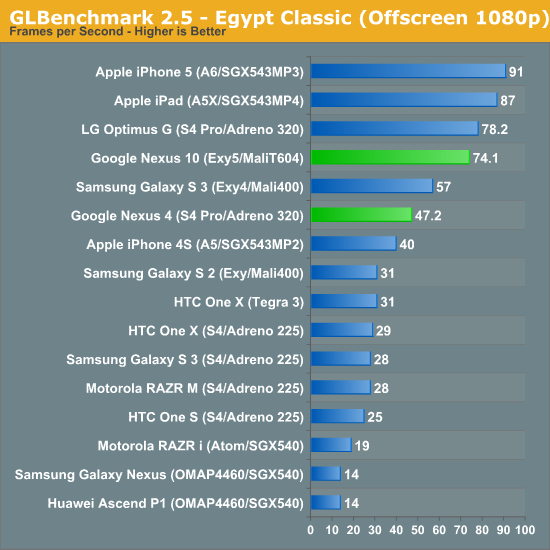
The Egypt Classic numbers are less interesting, but both platforms do well here.
Battery Life
We didn't have time to run through our entire battery life suite, but we do have some relevant results for the two devices. For smartphones, these are our latest web browsing battery life tests:
We regularly load web pages at a fixed interval until the battery dies (all displays are calibrated to 200 nits as always). The differences between this test and our previous one boil down to the amount of network activity and CPU load.
On the network side, we've done a lot more to prevent aggressive browser caching of our web pages. Some caching is important otherwise you end up with a baseband test, but it's clear what we had previously wasn't working. Brian made sure that despite the increased network load, the baseband still had the opportunity to enter its idle state during the course of the benchmark.
We also increased CPU workload along two vectors: we decreased pause time between web page loads and we shifted to full desktop web pages, some of which are very js heavy. The end result is a CPU usage profile that mimics constant, heavy usage beyond just web browsing. Everything you do on your smartphone ends up causing CPU usage peaks - opening applications, navigating around the OS and of course using apps themselves. Our 5th generation web browsing battery life test should map well to more types of smartphone usage, not just idle content consumption of data from web pages.
As always we test across multiple air interfaces (3G, 4G LTE, WiFi), but due to the increased network load we actually find that on a given process technology we see an increase in battery life on faster network connections. The why is quite simple to understand: the faster a page is able to fully render, the quicker all components can drive down to their idle power states.
All Android tests use Chrome and 5GHz WiFi unless otherwise listed.
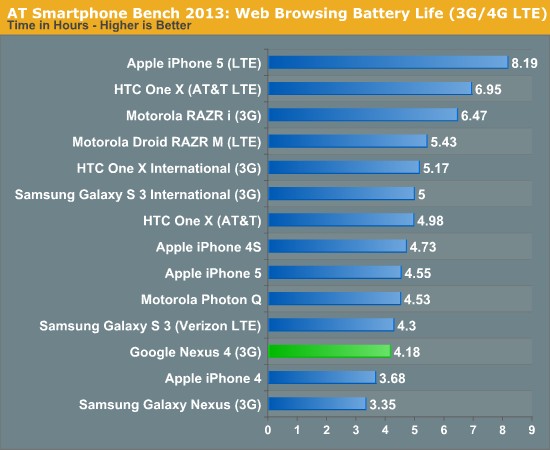
The Nexus 4 doesn't break any records for 3G battery life, it ends up relatively low on our list - even the Galaxy S 3 manages to do better here on 3G.

WiFi battery life is similar to the Galaxy S 3, but again it's not all that impressive compared to some of the other devices in this list.
Our tablet web browsing battery life test isn't directly comparable to the new smartphone tests, so we've got a separate chart for the Nexus 10:
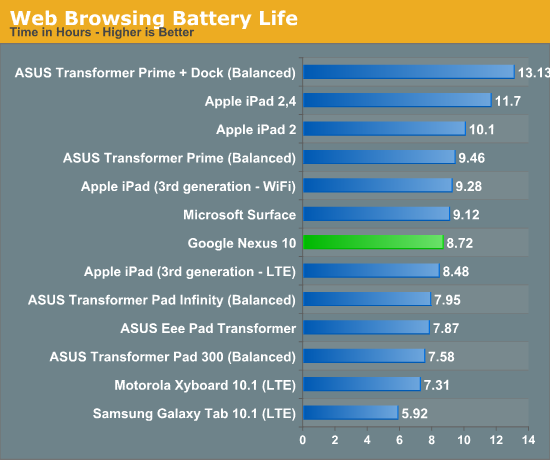
Despite driving a very high res panel, Google is able to deliver relatively competitive battery life with the Nexus 10. Battery capacity is around 80% the size of the 3rd gen iPad and battery life is around 93% of what Apple delivers here. Over 10 hours would be nice to have, but 8 hours of use in this test isn't bad at all. We'll have to do more testing to understand Exynos 5's power behavior a bit better, but so far it doesn't seem that the platform is all that bad from a power consumption standpoint. It remains to be seen how gracefully the Nexus 10 will handle being taxed heavier.
Display
We're still running our big display analysis routines on the new Nexus devices, but the brightness/contrast data below is a little teaser:
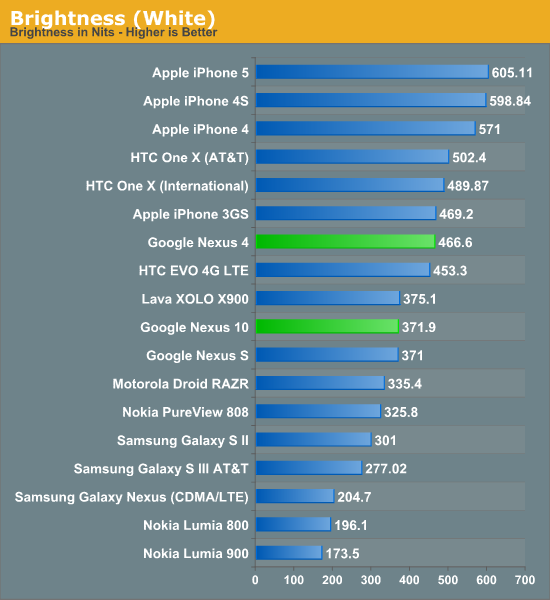
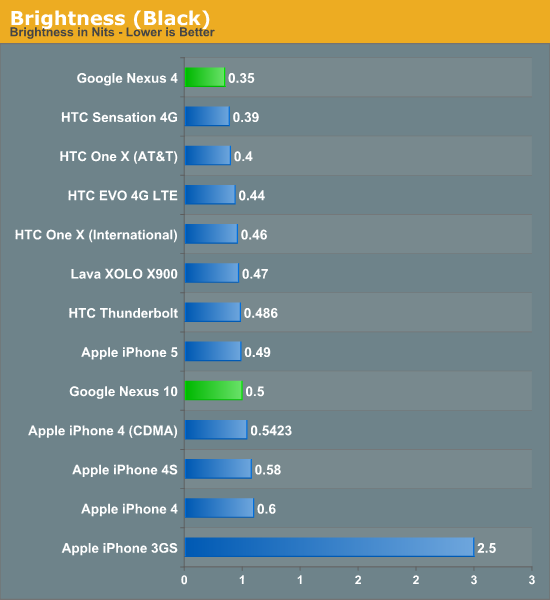
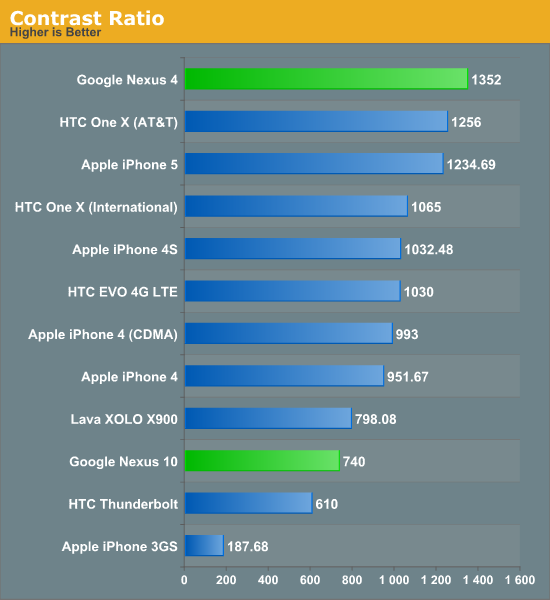
Final Words
We still have a lot of additional writing and testing ahead of us. Stay tuned for our full review of both devices!










244 Comments
View All Comments
Chloiber - Friday, November 2, 2012 - link
I'm extremely disappointed with the performance of the Nexus 4.You compare it (that's not meant as critique, as it's not officially available yet in most countires) with ICS devices. The performance increase with 4.1.1./4.1.2 is huge. The One X (Tegra 3) for example, scores a bit over 1000ms in SunSpider and 7000 in Quadrant.
The Nexus 4 however, despite having 4.2 on board is behind nearly everything else with comparable processors. I really hope it's just a 4.2 issue that will be fixed soon!
r3loaded - Friday, November 2, 2012 - link
Something certainly is iffy with the results as the mostly identical Optimus G seems to be beating the Nexus 4 by significant margins. I'm guessing a lot has to do with the benchmarking software not being updated for 4.2.Also, I wouldn't put any faith in the browser tests - he's using the stock browser for Android phones which isn't as quick as Chrome for Android.
nyarlathotep2 - Friday, November 2, 2012 - link
I don't know about Chrome being faster than the stock browser. On my devices, the stock android browser pretty much demolishes Chrome on the benchmarks, and I actually prefer the way it renders (I love Chrome on my PC's).But, oddly enough, my old Tegra 2 device browser-benchmarks considerably better than what I've seen listed for many newer (and certainly faster in other benchmark) devices.
TF101, running JB 4.1.2, slightly overclocked at 1200:
Stock Android Browser/Chrome
Sunspider: 1280 ms/1630ms
Kraken: 22,300 ms/24,828 ms
Browsermark: 161,925/123,350
Octane: 1527/1389
I find it odd that these scores from a tired old device are generally better than what I have seen listed for newer/faster devices, often with more cores.
Chloiber - Friday, November 2, 2012 - link
As I said: Jellybean! Huge improvements were made there. A HTC One X with Jellybean scores under a little bit over 1000ms in SunSpider. So just imagine how those scores would look like if the other phones got updated to JB. The Nexus 4 would be WAY behind, even though it has NEWER software.Also, the battery life is extremely weak. Compare it to the One X (granted that it has that companion core). Quadcore 40nm vs. Quadcore 28nm. 1600mAH vs. 2100mAH. The One X lasts way longer.
c4v3man - Friday, November 2, 2012 - link
Comparing a Verizon LTE phone against and AT&T LTE phone will yield different results, especially if there are significant coverage differences. For example, HTC One X AT&T vs Galaxy S3 Verizon on your chart. They both use the same radio platform basically, but obviously they have other factors such as the screen (SAMOLED takes more power than the One X's LCD) etc. However, when seeing the iPhone's numbers, we have no idea what carrier you're testing with.dstephens80 - Friday, November 2, 2012 - link
the extremely high latency shown in the speedtest screenshot? I sincerely hope that 1417ms ping times are a fluke and not the norm. who cares if you have 22Mb d/l speed when it takes 1.4s between packets.nidz1 - Friday, November 2, 2012 - link
That ping time is not accurate. I frequently see a high ping when starting a Speedtest, but if I ping the ip of the test server in terminal emulator I'll see 60-85ms, which is definitely normal. I think it has to do with the radio coming out of power save. Try it for yourself. I'm using T-Mobile, btw.Krysto - Friday, November 2, 2012 - link
It seems Google hasn't changed the V8 engine in Chrome for Android pretty much since they officially launched it. Not to mention Chrome for Android just got upgraded to version 18, when we're supposed to get version 23 in a week or two on the desktop. Incredible. The Chrome browser is close to a year behind in Javascript improvements compared to Apple and its Safari for iOS which probably got upgraded just before launching iOS6.It's very disappointing to see the very same chip score twice as slow in Chrome, because Google can't be bothered to treat it as seriously as they do on the desktop.
AnotherHariSeldon - Friday, November 2, 2012 - link
I don't see how Google (or Samsung etc) can compete with Apple gen for gen until they switch to using Imagination's SGX as opposed to ARM's Mali. Particularly given the next gen "Rogue" architecture that will further widen the performance gap with an order of magnitude increase in performance.http://www.anandtech.com/show/5364/powervr-series-...
meloz - Friday, November 2, 2012 - link
>I don't see how Google (or Samsung etc) can compete with Apple gen for gen until they switch to using Imagination's SGX as opposed to ARM's Mali.I can actually see them giving up on ARM altogether and going with new generation Intel Atoms from 2014 on.